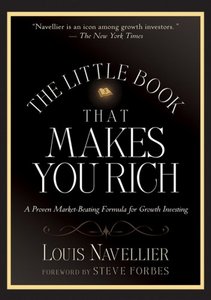This is the last book I read. Copy-pasting its review from my investing blog
Book Review - The Little Book That Makes You Rich by Louis Navellier

Introduction:
This is 3rd book I read in “Little Book Big profit” series. The 1st one was “The little book that beats the market” by Joel Greenblatt where he explains his magic formula based on ROE and Earning Yield (1/PE). The 2nd one was “The little book that builds wealth” by Pat Dorsey, where he rightly advocated on investing in stocks with moat.
In this book Navellier explain his growth investing stock approach, which at surface looks like a extension of Greenblatt’s magic formula. Rather then using just 2 variables of magic variables, he uses 8 parameters to select stocks. Those are:-
- Increasing EPS revisions
- Positive EPS surprises
- Increasing Sales growth
- Increasing Margin
- Strong Cash Flow
- Earning growth
- Positive earning momentum
- High ROE
Rational behind Navellier’s Approach:-
Navellier is very good in maths, and he use a pure number based approach. His approach will be a big disappointment for those who feel number based approach only tells story about the fact, and nothing about the future growth potential. His rational for using number based approach comes from behavioral finance and human’s psychological limitations, along with some nice observations on how market works. Here are his reasonings
- Using numbers one can see slowing earning growth/price volatility (Enron was a huge growth story before its earning slowed down and gone kaput)
- Numbers doesn’t have emotions. Human’s emotional shortcomings which can be overridden by numbers
- Gambler’s fallacy : Believing that the probability of getting a head is higher after getting 5 consecutive heads
- Falling in love with stocks/idea : People tend to fall in love with stocks and idea, especially the one have rose heavily.
- Hindsight theory : Everyone see in coming (like subprime crisis). No one exit at right time and loose money. Using a number based approach one can see these trends well in advance
- **Rearview mirror effect **: People are usually more influenced by what happened recently than by what is happening now – Buying @peak, Selling @Bottom
- 80% of the folks thinking they are better than the average
- Like to have our views confirmed by other/so-called experts.
- Congradulating ourself for our success and blaming others for our failures
Details on the parameters he uses:-
-
Increasing Earning Revisions : <<Mostly a US market theory>>
- Analyst tends to be on the lower side so as not to be blamed when the real result is far less than estimate
- Too many bullish estimate missing the target - the analyst will loose a well paying job
- Hence analyst don’t revise target unless there is a compelling reason to do so
-
Earning Surprises :
- Growth stocks are valued on expected future earnings; future earnings are found out by using models by the analysts
- Earning surprises forces the model upgradation, resulting in increased future earning estimate, and hence increased price
- Regular earning surprises → Growth mega star
-
Sales Growth :
- Sales numbers are usually very difficult to massage by accounting glimmics
- Key observables : QoQ sales growth, Yoy sales growth
- 2 reasons why there can be sales growth
- Popular product → best selling stuffs
- Supply demand imbalance
- Company that shows lasting growth in sales are going to produce returns that are not dependent on overall market or economy
- Slowing sales growth is ==> Fastest way to get kicked out of his portfolio
-
Free Cash Flow
- More free cash flow implies
- financing of new business by internal accruals
- pay and raise dividends
- Stock buyback
Details on the parameters he uses:-
- More free cash flow implies
-
Risk
- He don’t use beta as a measure of risk
- He measures reward/risk as alpha/Standard-deviation-of-alpha as the measure of risk. SD is calculated on last 1 yr data
- He grades all the stocks as A, B, C, D, E based on reward/risk ratio
-
Zig-zag approach of investing
- Observation : Few of the stocks have positive beta, few have negative beta
- Approach : Multi-objective optimization of selection of stock with the aim of
- Maximizing alpha
- beta as close as zero
- 60/30/10 approach
- 60% : conservative stock
- 30% : Moderately aggressive stock
- 10% : Aggressive stock
Conclusion:-
-
It is a well known fact that growth investing out-perform value investing in long run; and being the 1st book I am reading on growth investing, I loved it
-
One area where I differ with it is on risk. Though I am not a big fan of use of greek bearing formula for calculating risk, but his measure of reward/risk make sense to me. I prefer to have a smooth positively growing difference between my portfolio return and sensex return with minimum volatility in the curve. This boils down to something like alpha/SD-alpha approach
-
Many reviews present in the web, tends to tell that they didn’t enjoy this book as the other book in this series. I must say I enjoyed this book till the chapter on zig-zag investing. After that I pretty much skimmed through rest of the chapters, which I found not so educating.**
**
Other reviews of same:- -
http://www.thesimpledollar.com/2007/10/19/review-the-little-book-that-makes-you-rich/
-
http://www.onlineinvestingai.com/blog/review-of-the-little-black-book-that-makes-your-rich/
-
http://behaviouralinvesting.blogspot.in/2007/11/little-book-that-makes-you-rich.html **
**
